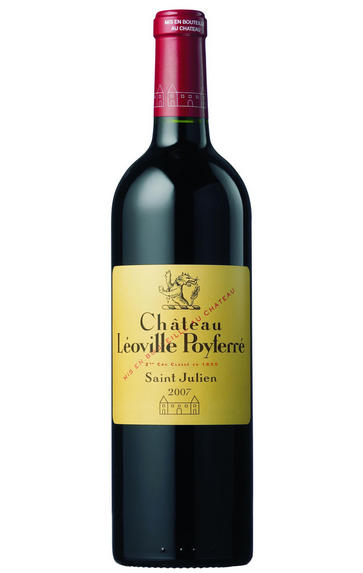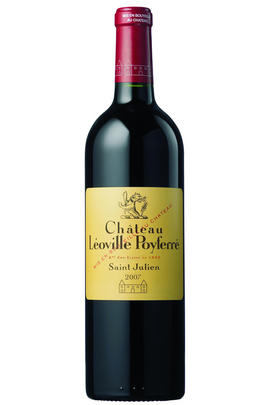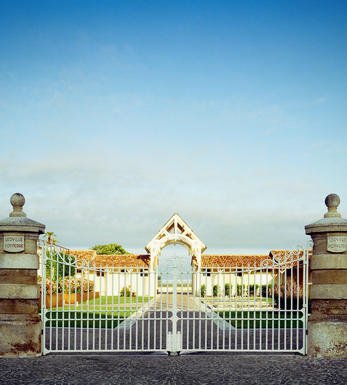
2014 Château Léoville Poyferré, St Julien, Bordeaux

Critics reviews
The 2014 Léoville-Poyferré is one of the standout Left Bank wines of the vintage. Demonstrating outstanding clarity and freshness on the nose, this seems to just "leap" out of the glass like an over-excited Yorkshire terrier. The palate is medium-bodied with lithe tannins, silky smooth in texture, a perfect line of acidity and a harmonious finish that slips down the throat. This is going to be irresistible for the next 20 years. Tasted at the Léoville-Poyferré vertical at the château with Sara Lecompte Cuvelier.
Drink 2021 - 2050
Neal Martin, Vinous.com (September 2022)
Tasted two times.
The 2014 Léoville Poyferré is gorgeous. Dark, sumptuous and ample on the palate, it possesses remarkable depth. Dark cherry, plum, smoke, scorched earth, licorice and menthol all flesh out as this radiant, deeply expressive wine shows off its considerable pedigree. The 2014 is going to need time to fully come together, but it is super-impressive.
Drink 2020 - 2039
Antonio Galloni, Vinous.com (February 2017)
Cassis and raspberry fruits, smoked and grilled oak notes, this is highly moreish, a little more savoury in its Cabernet Sauvignon expression than you often find at Poyferré, with raspberry leaf, graphite, undergrowth and baked earth. The tannins remain a little angular, and I suggest another few years in bottle. 80% new oak, harvest October 1 to 14.
Drink 2025 - 2048
Jane Anson, JaneAnson.com (February 2024)
Tasted blind. Black with garnet rim. Leafy black fruit scents. Slightly tarry. Compact, fine tannins. Not particularly richly/sweetly fruited at the core but there’s density, balance and harmony for a long life.
Drink 2027 - 2038
Julia Harding MW, JancisRobinson.com (February 2024)
A ripe, generous and substantial wine for this appellation with some real concentration. Plenty of beautiful currant and blackberry character, as well as a solid core of ripe, dusty and velvety tannins and enough acidity to carry the long, savoury finish. A beauty.
Better in 2024
James Suckling, JamesSuckling.com (February 2021)
60% Cabernet Sauvignon, 35% Merlot, 3% Cabernet Franc, 2% Petit Verdot. Harvest 1-14 October.
Real perfume on the nose here, so floral with peonies, rich blackcurrants and summer berry notes. Lovely clarity and precision on the palate, soft and delicate with such poise. It's not so expansive right now, a little shy perhaps, but the quality is excellent with the terroir signatures of wet stone and graphite coming through. This has just an easy-drinking appeal, delicately layered but with a juiciness and tannic structure that will ensure a long life ahead.
Drink 2024 - 2046
Georgina Hindle, Decanter.com (March 2022)
A blend of 60% Cabernet Sauvignon, 35% Merlot 3% Cabernet Franc and the balance Petit Verdot that wasn’t harvested until the middle of October (this is later than most), the 2014 Léoville Poyferré is a ripe, concentrated, seriously impressive wine in the vintage that offers more exuberance, texture, and character than most. Crème de cassis, graphite, toasty oak, and hints of tobacco all emerge from this purple-coloured, pure, medium to full-bodied 2014 that has sweet tannin, beautiful purity of fruit, and a great finish. While it doesn’t have the depth of a truly great vintage, it shines for its balance, texture, and sheer charm.
Drink 2018 - 2038
Jeb Dunnuck, JebDunnuck.com (February 2018)
About this WINE

Château Léoville Poyferré
Château Léoville Poyferré is a wine estate in St Julien on the Left Bank of Bordeaux. It was once part a larger estate called Léoville, which was established in 1638 and divided up centuries later following the death of its owner. That original estate gave rise to the three separate properties now called Léoville Barton, Léoville Las Cases and Léoville Poyferré. The latter took its name in 1840 from Baron Jean-Marie de Poyferré, who inherited the estate along with his wife, the daughter of Jeanne de Las Cases. Léoville Poyferré, like Barton and Las Cases, was ranked a Second Growth in the 1855 classification.
The estate has been owned and run since 1920 by the Cuvelier family. Having established themselves as wine merchants in Lille in Northern France, the family had recently bought Château Le Crock in St Estèphe before expanding into St Julien with both Léoville Poyferré and Château Moulin Riche. The family firm is led today by Sara Lecompte Cuvelier, who took over from her uncle Didier Cuvelier in 2017. She works with long-time winemaker Isabelle Davin. Michel Rolland has been the consultant here since the mid-1990s.
The portfolio here includes the grand vin, Château Léoville Poyferré, along with the estate’s second wine, Pavillon de Léoville Poyferré. Moulin Riche was once considered an unofficial second wine of Léoville Poyferré but has since 2009 been very much its own estate wine.

St Julien
St Julien is the smallest of the "Big Four" Médoc communes. Although, without any First Growths, St Julien is recognised to be the most consistent of the main communes, with several châteaux turning out impressive wines year after year.
St Julien itself is much more of a village than Pauillac and almost all of the notable properties lie to its south. Its most northerly château is Ch. Léoville Las Cases (whose vineyards actually adjoin those of Latour in Pauillac) but, further south, suitable vineyard land gives way to arable farming and livestock until the Margaux appellation is reached.
The soil is gravelly and finer than that of Pauillac, and without the iron content which gives Pauillac its stature. The homogeneous soils in the vineyards (which extend over a relatively small area of just over 700 hectares) give the commune a unified character.
The wines can be assessed as much by texture as flavour, and there is a sleek, wholesome character to the best. Elegance, harmony and perfect balance and weight, with hints of cassis and cedar, are what epitomise classic St Julien wines. At their very best they combine Margaux’s elegance and refinement with Pauillac’s power and substance.
Ch. Léoville Las Cases produces arguably the most sought-after St Julien, and in any reassessment of the 1855 Classification it would almost certainly warrant being elevated to First Growth status.
Recommended Châteaux: Ch. Léoville Las Cases, Ch.Léoville Barton, Ch Léoville Poyferré, Ch. Ducru-Beaucaillou, Ch Langoa Barton, Ch Gruaud Larose, Ch. Branaire-Ducru, Ch. Beychevelle

Cabernet Sauvignon Blend
Cabernet Sauvignon lends itself particularly well in blends with Merlot. This is actually the archetypal Bordeaux blend, though in different proportions in the sub-regions and sometimes topped up with Cabernet Franc, Malbec, and Petit Verdot.
In the Médoc and Graves the percentage of Cabernet Sauvignon in the blend can range from 95% (Mouton-Rothschild) to as low as 40%. It is particularly suited to the dry, warm, free- draining, gravel-rich soils and is responsible for the redolent cassis characteristics as well as the depth of colour, tannic structure and pronounced acidity of Médoc wines. However 100% Cabernet Sauvignon wines can be slightly hollow-tasting in the middle palate and Merlot with its generous, fleshy fruit flavours acts as a perfect foil by filling in this cavity.
In St-Emilion and Pomerol, the blends are Merlot dominated as Cabernet Sauvignon can struggle to ripen there - when it is included, it adds structure and body to the wine. Sassicaia is the most famous Bordeaux blend in Italy and has spawned many imitations, whereby the blend is now firmly established in the New World and particularly in California and Australia.


Buying options
Add to wishlist
Description
60% Cabernet Sauvignon, 35% Merlot, 2% Petit Verdot, 3% Cabernet Franc.
There is fleshy, tasty fruit here, and a lovely intensity on the nose. The bouquet is beautifully expressive and laced with sweet, dark fruits. Cassis and dark fruit continue to dominate on the palate, the crunchy tannins a welcome arrival. The wine is very dark, and you can sense an underlying power, even though it doesn't express itself that way, yet. A wine to be cellared for several years, it will reward those with patience. Well balanced, harmonious and, dare I say it, a classic Poyferré.
Berry Bros. & Rudd
wine at a glance
Delivery and quality guarantee